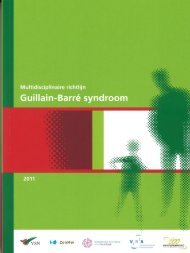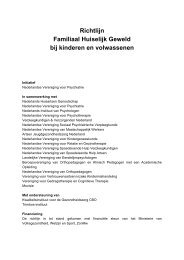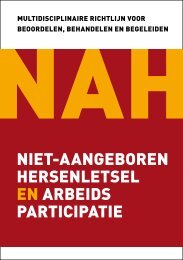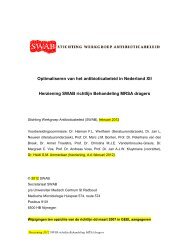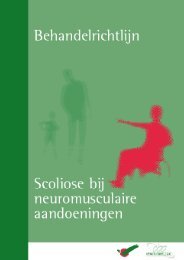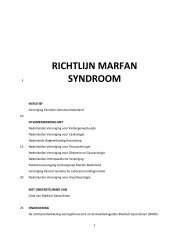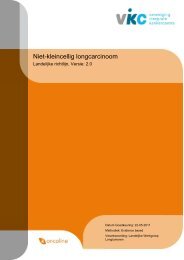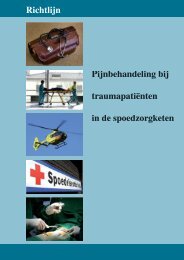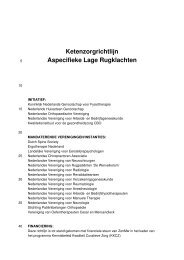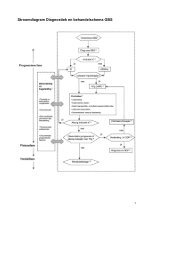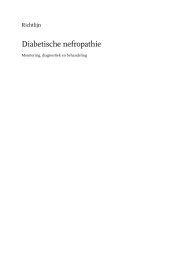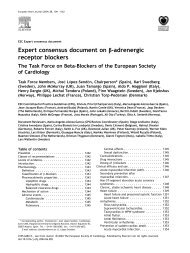Richtlijn: Otitis Externa - Kwaliteitskoepel
Richtlijn: Otitis Externa - Kwaliteitskoepel
Richtlijn: Otitis Externa - Kwaliteitskoepel
Create successful ePaper yourself
Turn your PDF publications into a flip-book with our unique Google optimized e-Paper software.
difference in cure rates at 2 to 4 days (RD, – 0.01; 95% CI, – 0.21 to 0.18) or at 5 to 6 days (RD 0.08;<br />
95% CI, – 0.15 to 0.30).<br />
Resistance and Therapeutic concentration<br />
An advantage of topical therapy is the very high concentration of antimicrobial that can be delivered<br />
to infected tissue, often 100 to 1000 times higher than can be achieved with systemic therapy. For<br />
example a 0.3% solution of antibiotic (a typical concentration in commercial otic drops) has a<br />
concentration of 3000 mcg/mL. Any organisms known to cause AOE, even those considered<br />
“resistant,” will be unlikely to survive contact with this antibiotic concentration. Because there are<br />
between 10 to 20 drops/mL, depending on the nature of the liquid (solution vs suspension, viscosity,<br />
etc), each dose of 3 to 5 drops contains about 0.5 to 1.5 mg of antibiotic.<br />
Topical therapy avoids prolonged exposure of bacteria to subtherapeutic concentrations of<br />
antibiotic, and may therefore be less likely than systemic therapy to result in selective pressure for<br />
resistant organisms (Roland 2002, Weber 2004). The avoidance of antibiotic exposure of host<br />
bacteria resident outside the ear canal, as occurs with systemic therapy, provides a further<br />
advantage to the reduction of the selection of resistant microorganisms. Restrictive use of oral<br />
antibiotics for AOE is important because of the increased resistance among common AOE pathogens,<br />
especially S aureus and P aeruginosa (Walshe 2001, Cantrell 2004).<br />
Topical treatment without antibiotics<br />
Effective topical treatments include acetic acid (Balen van 1993, Cannon 1970, Kime 1978, Ordonez<br />
1978), boric acid (Slack 1978), aluminum acetate (Clayton 1990, Lamber 1981), silver nitrate<br />
(Smathers 1977, Hasselt van 2004), and an endogenous antiseptic N-chlorotaurine (Neher 2004).<br />
Topical steroids are also effective, as a single agent (Ruth 1990, Tsikoudas 2002, Emgard 2005), or in<br />
combination with acetic acid (Balen van 1993, Kime 1978, Ordonez 1978) or an antifungal<br />
preparation (Bak 1983). When the success of these nonantibiotic therapies is considered, it is likely<br />
that for cases of uncomplicated AOE, oral antibiotics, particularly those with no activity against P<br />
aeruginosa or S aureus, are unnecessary. From the Cochrane review becomes apparent that most<br />
topical treatments are equally effective (Kaushik 2010).<br />
Lifestyle recommendations during treatment<br />
Along with prescribing topical antimicrobials, clinicians should advise patients to resist manipulation<br />
to minimize ear trauma and should discuss issues that pertain to water restrictions during treatment.<br />
The insertion of earplugs or cotton (with petroleum jelly) before showering or swimming can reduce<br />
the introduction of moisture into the ear. The external auditory canal can be dried after swimming or<br />
bathing with a hair dryer on the lowest setting. Patients with hearing aids or ear phones should limit<br />
insertion until pain and discharge (if present) have subsided.<br />
Conclusies<br />
Level of evidence 1<br />
Roland 2008<br />
Yelland 2003<br />
Level of evidence 1<br />
There is no evidence that systemic antibiotic treatment has an<br />
additional value compared to topical treatment alone in otherwise<br />
healthy individuals with acute otitis externa.<br />
Most topical treatments are equally effective.<br />
Kaushik 2010<br />
22 <strong>Richtlijn</strong> <strong>Otitis</strong> <strong>Externa</strong> 2010<br />
Nederlandse Vereniging voor Keel-Neus-Oorheelkunde en Heelkunde van het Hoofd-Halsgebied




